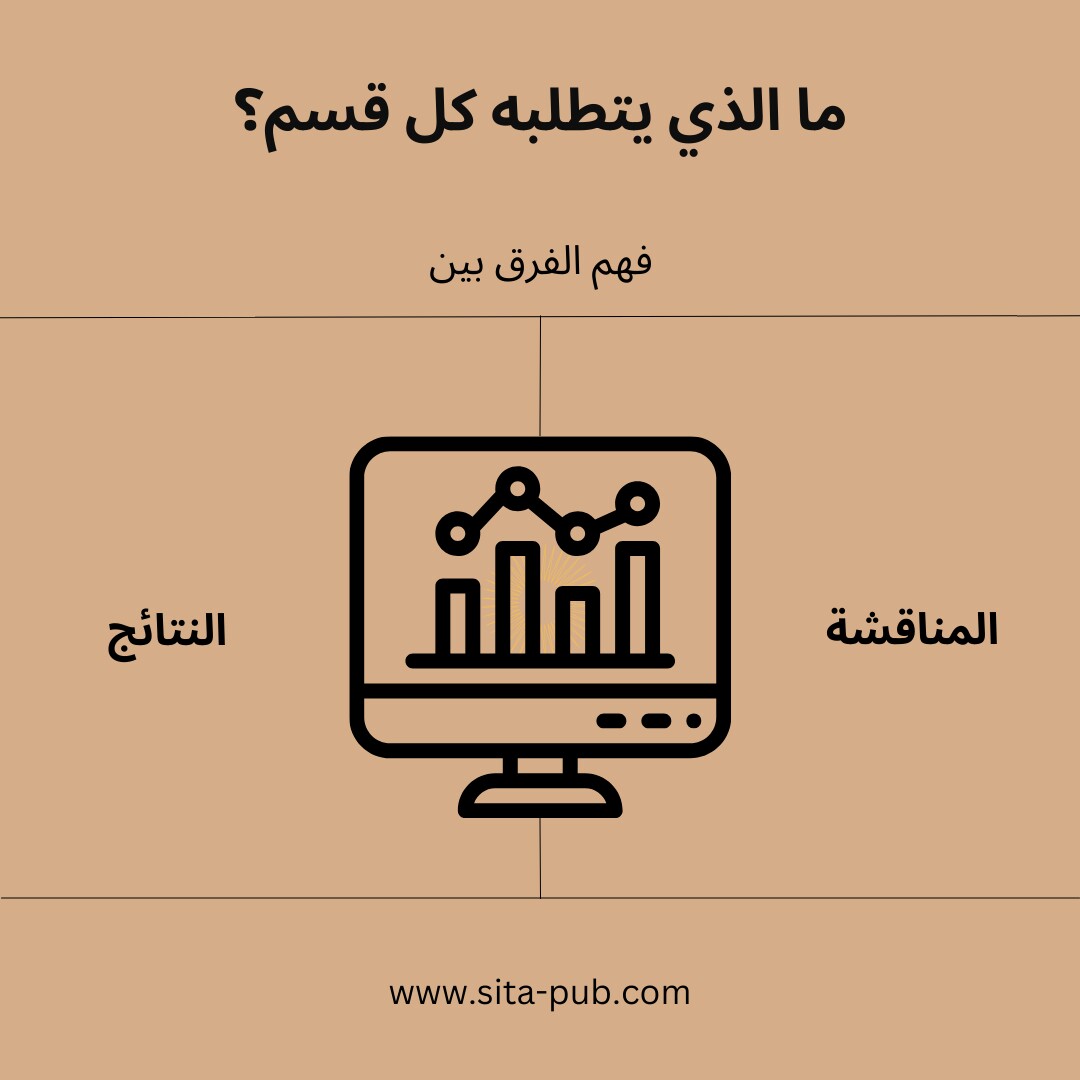فهم الفرق بین قسم النتائج والمناقشه: ما الذی یتطلبه کل قسم


عند کتابه ورقه بحثیه، یُعتبر قسم النتائج والمناقشه من الأجزاء الأساسیه. إن فهم الفرق بین هذین القسمین أمر بالغ الأهمیه لعرض نتائجک بشکل واضح. کل قسم له غرض محدد ویتطلب نوعًا مختلفًا من المحتوى. دعونا نستعرض ما یتضمنه کل قسم.

قسم النتائج هو المکان الذی تقدم فیه البیانات والنتائج التی توصلت إلیها من بحثک. یجب أن یکون هذا الجزء من الورقه مباشرًا ویرکز على الحقائق. إلیک ما یجب أن یتضمنه:
فی قسم النتائج، یجب أن تعرض بیاناتک بوضوح. یمکن القیام بذلک باستخدام الجداول، والرسوم البیانیه، والأشکال. یجب أن تکون کل أداه بصریه معنونه بشکل صحیح، ویجب علیک الإشاره إلیها فی النص. على سبیل المثال، یمکنک القول: "کما هو موضح فی الشکل 1، تشیر النتائج إلى…". یساعد ذلک القارئ على فهم البیانات بسرعه.
من المهم تلخیص نتائجک الرئیسیه باستخدام الإحصائیات الوصفیه. یشمل ذلک تقدیم المتوسطات (المتوسطات الحسابیه)، والتفاوتات (الانحرافات المعیاریه)، وأی اختبارات إحصائیه قمت باستخدامها. على سبیل المثال، إذا أجریت مسحًا، قد تقدم متوسط الدرجات وکیفیه اختلاف الدرجات بین المشارکین.
فی قسم النتائج، التزم بالحقائق فقط. تجنب تفسیر البیانات أو مناقشه دلالاتها هنا. هدفک هو تقریر ما وجدته، ولیس شرح ما یعنیه ذلک. یساعد هذا فی الحفاظ على وضوح القسم وترکیزه.
نظم نتائجک بطریقه منطقیه. قد یتبع هذا غالبًا تسلسل أسئله البحث أو الفرضیات التی طرحتها. على سبیل المثال، إذا کانت لدیک ثلاث أسئله رئیسیه، اعرض النتائج المتعلقه بالسؤال الأول، ثم الثانی، وهکذا. یساعد هذا الترتیب القراء فی متابعه نتائجک بسهوله.
هدفک فی الکتابه هو الوضوح. استخدم لغه بسیطه وکن مختصرًا. تجنب الشروحات الطویله أو التفاصیل غیر الضروریه. یجب أن یکون قسم النتائج سهل القراءه والفهم.

قسم المناقشه هو المکان الذی تفسر فیه نتائجک وتشرح دلالتها. یتیح لک هذا القسم تحلیل نتائجک وربطها بالأبحاث السابقه. إلیک ما یجب أن یتضمنه:
ابدأ بمناقشه ما تعنیه نتائجک. اشرح الأنماط، والاتجاهات، أو النتائج غیر المتوقعه التی لاحظتها. على سبیل المثال، إذا أظهرت نتائجک أن علاجًا معینًا کان فعالًا، فاشرح لماذا تعتقد أنه نجح.
ربط نتائجک بالدراسات السابقه. ناقش کیف تدعم نتائجک أو تختلف عن ما وجدته الأبحاث الأخرى. تساعد هذه المقارنه فی وضع بحثک فی سیاق أوسع. على سبیل المثال، "تتوافق نتائجنا مع ما ذکره سمیث وآخرون (2020)، الذین وجدوا نتائج مشابهه..."
ناقش التداعیات الأوسع لنتائجک. کیف تساهم فی مجالک؟ ماذا قد تعنی بالنسبه للممارسات، أو السیاسات، أو الأبحاث المستقبلیه؟ على سبیل المثال، إذا کان بحثک یقترح أن علاجًا جدیدًا فعال، ناقش کیف قد یغیر ذلک الممارسات الحالیه.
من المهم الاعتراف بأی قیود فی دراستک. قد یشمل ذلک عوامل مثل حجم العینه الصغیر أو التحیز المحتمل. یعکس الاعتراف بالقیود أنک تمتلک فهماً نقدیًا لعملک ویساعد القراء فی تفسیر نتائجک بشکل مناسب.
اقترح مجالات للبحث المستقبلی بناءً على نتائجک. قد یشمل ذلک أسئله ما زالت دون إجابه أو مجالات بحث جدیده فتحتها نتائجک. على سبیل المثال، یمکنک القول: "یجب على الدراسات المستقبلیه استکشاف..."
الجانب | قسم النتائج | قسم المناقشه |
|---|---|---|
الهدف | عرض البیانات والنتائج | تفسیر وشرح دلاله النتائج |
المحتوى | بیانات، جداول، رسومات، وإحصائیات | تحلیل، دلالات، مقارنات |
النغمه | موضوعیه وواقعیه | تحلیلیه وتفسیریه |
الترکیز | ما تم العثور علیه | ما تعنیه النتائج ولماذا هی مهمه |
الترتیب | ترتیب منطقی بناءً على أسئله البحث | تلخیص النتائج وربطها بالأدبیات الحالیه |
القیود | عاده لا یتم تضمینها | الاعتراف بقیود الدراسه |
الاتجاهات المستقبلیه | عاده لا یتم تضمینها | اقتراح مجالات للبحث المستقبلی |
فی الختام، یعد فهم الفرق بین قسم النتائج وقسم المناقشه أمرًا بالغ الأهمیه للکتابه العلمیه الفعّاله. یرکز قسم النتائج على تقدیم البیانات بطریقه واضحه وموضوعیه، بینما یفسر قسم المناقشه هذه البیانات ویشرح دلالتها. من خلال الفصل الواضح بین هذین القسمین، یمکنک تحسین وضوح تأثیر ورقتک البحثیه.
عند کتابه قسم النتائج، اسعى لتقدیم البیانات بشکل مباشر وتقریر موضوعی. فی قسم المناقشه، خصص الوقت لتحلیل ومقارنه وتأمل نتائجک. سیساهم هذا فی جعل ورقتک أکثر قابلیه للقراءه ویعزز أیضًا حججک وإسهاماتک فی مجالک. من خلال إتقان هذین القسمین، یمکنک التواصل بفعالیه مع جمهورک وتحقیق النجاح فی النشر.
إذا کان لدیک أی أسئله، استفسارات، أو ترغب فی معرفه المزید عن خدماتنا، فلا تتردد فی التواصل معنا. فریقنا المخصص مستعد لمساعدتک.